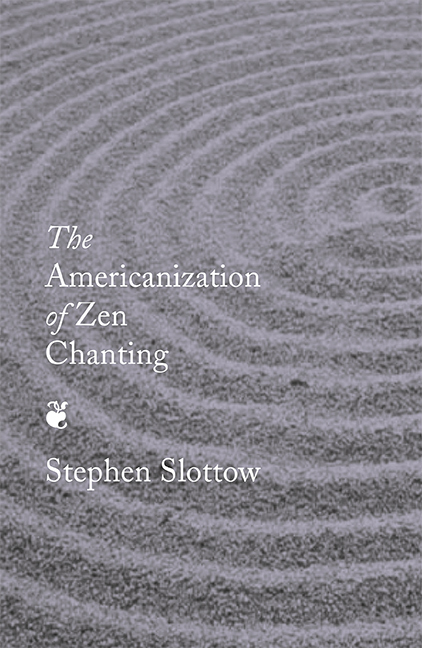Book contents
- Frontmatter
- Contents
- List of Examples
- Acknowledgements
- Chapter 1 Introduction
- Chapter 2 Purposes and Functions of Zen Chanting
- Chapter 3 Performance Practice
- Chapter 4 Typology, Translation, and Ceremonies
- Chapter 5 Conclusion
- Bibliography
- Discography and Videography
- Appendix: Alternative Chant Names
- Index
Chapter 3 - Performance Practice
- Frontmatter
- Contents
- List of Examples
- Acknowledgements
- Chapter 1 Introduction
- Chapter 2 Purposes and Functions of Zen Chanting
- Chapter 3 Performance Practice
- Chapter 4 Typology, Translation, and Ceremonies
- Chapter 5 Conclusion
- Bibliography
- Discography and Videography
- Appendix: Alternative Chant Names
- Index
Summary
Very broadly speaking, there are three styles of Japanese Zen Buddhist chanting. The first two are shōmyō and dokkyō. Shōmyō is elaborate, sophisticated, melodic, melismatic, and rhythmically varied. Dokkyō (sutra chanting) is syllabic, more or less monotonal, and chanted “in a constant, fixed rhythm, with one character of the text per beat” (Nelson 2008, 37). In dokkyō, a steady rhythm is usually kept by the beat of the mokugyo. A third category consists of chants that more closely resemble dokkyō than shōmyō, but do not have a steady beat and are often recited rather than intoned. Chanting in North American Zen Centers belongs overwhelmingly to the last two categories, although (as will be discussed later) there have been occasional innovations that don't fit into any of these categories.
The different types of chants will be discussed at length in Chapter 4; suffice it here to say that they can be categorized as sutras, dharanis, ekos (dedications), texts (recitations), and gathas (verses).
Chanting can be done solo, but in Japanese-derived American Zen is more often a group activity. Participants chant from a chant book or from memory. There is no standard term for the chanting leader. In Soto this person is called the Ino or Kokyō; in Rinzai, Densu or Inosu.3 My training took place at the Rochester Zen Center and in the Diamond Sangha—the term in the former is simply “lead chanter,” and in the latter, Ino. In the Pacific Zen Institute, the term is “cantor.” For convenience, in this study I will use the term Ino (which appears to be the most common). In many Harada-Yasutani lines, the Ino also plays most or all of the percussion instruments, a little like a Zen one-man band. In Soto and Rinzai, the Ino role is more that of a cantor, and (depending on the size of the group) other zendo officers play most or all of the instruments.
Instruments
Instrumentation, for the most part, has not been an area of innovation in American Zen, although there are exceptions towards the more experimental end of the spectrum. But in general the musical instruments used in American Zen Centers have been adopted virtually unchanged from Japan, which in turn adopted them from China.
- Type
- Chapter
- Information
- The Americanization of Zen Chanting , pp. 37 - 90Publisher: Boydell & BrewerPrint publication year: 2018



